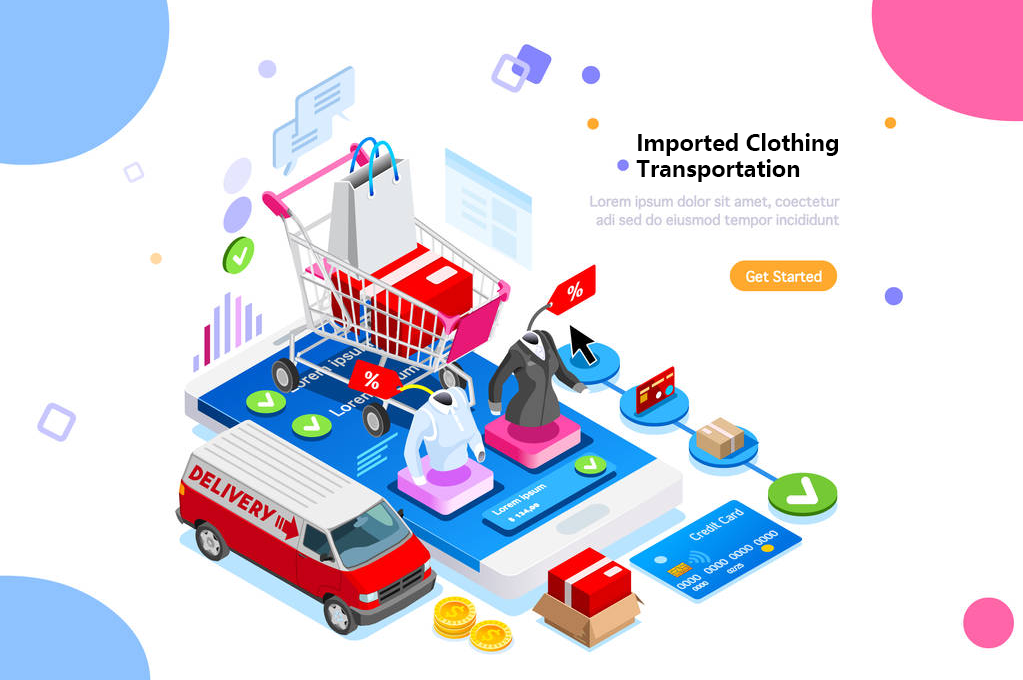Introduction to Import Garment Transportation:A Comprehensive Guide
Dear readers, in the previous article, we learned about the overview of Imported Clothing Transportation . This article mainly takes you to further understand what import garment is, what is import garment transportation, the key steps and importance of imported clothing transportation.
Introduction to Imported Clothing Transportation
What is Import Garment
Imported Apparel refers to the process of transporting clothing products from one country (typically the manufacturing country, such as China) to another country (usually the consumer market).
What is Imported Clothing Transportation
Imported clothing transportation is a specialized segment of the global logistics industry that focuses on the movement of clothing and textile products from their manufacturing locations to retail outlets, distribution centers, or warehouses in different countries. This process involves complex coordination across various modes of transport, including maritime shipping, pengangkutan udara, rail, and road networks, ensuring that garments reach their destination in optimal condition and within specified timeframes.

Key Steps in Importing Garment Transportation
Procurement and Contract Signing
Before imported clothing transportation begins, it is essential to identify a supplier and sign a contract that includes key terms such as product specifications, quantity, price, and delivery dates.
Production and Packaging
After completing the production of garments according to the contractual requirements, the next step is packaging. The garments must be properly packaged to prevent damage during long-distance transportation.
Common transport methods include maritime shipping, pengangkutan udara, rail, or courier services. The choice depends on the value, weight, volume of the goods, and the required delivery time.
Customs Clearance
When the goods depart from China, they must go through export customs clearance procedures. Upon arrival in the destination country, import customs clearance is required. This process involves submitting necessary documents such as commercial invoices, packing lists, and certificates of origin, along with paying the corresponding duties and taxes.
Domestic Distribution
Once international transportation has been successfully completed, we must then organize domestic logistics services to ensure that the goods are efficiently delivered to their specified end locations within the country.
Importance of Importing Garment Transportation
Ensuring Cargo Safety
Garment products often need to travel long distances from the manufacturing site to the retail destination. Throughout this process, ensuring the safety and integrity of the goods is critical. Professional garment transportation services offer appropriate packaging and handling methods to minimize the risk of damage during transit.
Time Management
The fashion industry is highly sensitive to timing, with seasonal and trend-driven demands requiring that garments reach the market on schedule. Efficient transportation services guarantee timely delivery, which is essential for meeting market demands, avoiding stock accumulation, and maintaining good customer relationships.

Cost Efficiency
Reasonable logistics arrangements can help businesses reduce transportation costs. By integrating transportation resources and optimizing route planning, unnecessary expenses can be minimized, improving the overall cost efficiency of the supply chain.
Compliance
Importing garments involves compliance with the laws and regulations of multiple countries and regions, including tariffs and inspection requirements. Professional transportation companies typically have experience handling these complex procedures, helping businesses avoid additional costs or delays due to unfamiliarity with local laws.
Environmental Sustainability
As consumer awareness of environmental issues grows, more brands are focusing on the carbon footprint of their logistics processes. Choosing service providers that adopt green transportation methods not only contributes to environmental protection but also enhances brand image.
What are the Modes of Transportation for Importing Garment
Pengangkutan laut
For bulk shipments, Pengangkutan laut remains the most cost-effective method. Container ships can carry thousands of units of clothing at once, making it ideal for large orders. However, sea transportation can take several weeks, depending on the distance traveled, which means planning ahead is crucial for importers to avoid stockouts.
Pengangkutan Udara
If it is a small batch or urgent delivery that cannot wait for slower sea routes, air freight is a good choice. Although pengangkutan udara costs are high, it can ensure that high-value or seasonal goods arrive quickly in the hands of buyers in emergency situations.
Rail and Road Transport
In regions where infrastructure supports it, rail and road networks provide alternative means of transporting garments over land. For example, rail links between China and Europe have become increasingly popular for garment shipments, offering a balance between cost and speed. Trucking is essential for last-mile delivery, moving goods from ports or airports to final destinations.

Challenges and Solutions Faced by Imported Clothing Transportation
Import garment transportation faces numerous challenges, including customs clearance procedures, varying regulations across borders, security concerns, and the need for tracking and visibility throughout the supply chain. To address these issues, logistics providers use advanced technology such as RFID tagging, GPS tracking, and blockchain to enhance traceability and reduce the risk of loss or theft.
Import garment transportation is not just about moving clothes from point A to B; it’s a sophisticated operation involving intricate logistics management systems designed to meet the evolving demands of the global fashion market. As consumer expectations continue to shift towards faster delivery times and greater transparency, the importance of efficient and reliable garment transportation services will only grow.
I hope this article can help you. If you need one-stop clothing transportation services, please contact us:NEW SPEED International Logistics Company.

